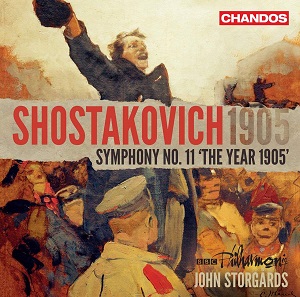 Dmitri Shostakovich: Symphonie Nr. 11 (1905); BBC Philharmonic Orchestra, John Storgards; 1 SACD Chandos CHSA 5278; Aufnahme 08/2019, Veröffentlichung 04/2020 (66'45) - Rezension von Remy Franck
Dmitri Shostakovich: Symphonie Nr. 11 (1905); BBC Philharmonic Orchestra, John Storgards; 1 SACD Chandos CHSA 5278; Aufnahme 08/2019, Veröffentlichung 04/2020 (66'45) - Rezension von Remy Franck
Einen Mangel an guten Aufnahmen von Shostakovichs 11. Symphonie gibt es nicht, an herausragenden schon. Die letztgenannte Kategorie erfährt mit dieser Neuproduktion keinen Zugang.
John Storgards nimmt sich Zeit für den ersten Satz, er kostet das Adagio wohl spannungsvoll aus (aber nicht elektrisierend knisternd) und lässt dem Zuhörer Zeit, das wunderbar ausbalancierte und feine Spiel des Orchesters in einem äußerst gepflegten und warmen Schönklang zu genießen.
Auch im zweiten Satz beeindruckt der Dirigent vor allem mit Klangkontrolle, Ausgewogenheit und Transparenz, allerdings auf Kosten der Dramatik. Shostakovichs meisterhafte Orchestrierung aber wird luxuriös bedient.
Der dritte Satz, In memoriam, wird sehr verhalten inszeniert und auch auf dem Höhepunkt herrscht orchestrale Sachlichkeit vor.
Der letzte Satz, Sturmgeläut, wird von Storgards leicht und unbeschwert dirigiert, als handele es sich um ein Pferderennen oder ein ähnliches Sportereignis. Nach dem reflektiven Mittelteil wird die Coda nicht zuletzt durch die Verwendung richtiger Glocken packend gestaltet.
An die Aufnahme mit dem Russian National unter Pletnev erinnernd ist dies eine Elfte Symphonie mit viel Schönklang in zeitloser Eleganz, ein fein gestaltetes Orchesterstück fernab jeder geschichtsbeladenen Dramatik und Erinnerung an die Brutalitäten des Jahres 1905.
There is no lack of good recordings of Shostakovich’s 11th Symphony, but there is a lack of outstanding ones. This new production does certainly not belong to the latter category.
John Storgards takes his time for the first movement, he savours the Adagio in a suspenseful, but not electrifying way and allows the listener to enjoy the wonderfully balanced and fine playing of the orchestra in an extremely cultivated and warm, beautiful sound.
Also in the second movement the conductor impresses above all with sound control, balance and transparency, but at the expense of drama. Shostakovich’s masterful orchestration, however, is luxuriously served.
The third movement, In memoriam, is very restrained, and orchestral objectivity prevails even at the climax.
The last movement, Sturmgeläut, is light and easy-going, as if it were a horse race or a similar sporting event. After the reflective middle section, the coda is gripping especially by the use of real bells.
Reminding me the recording with the Russian National under Pletnev, this is a beautifully shaped Eleventh Symphony with timeless elegance, far from the historical drama and the brutalities of 1905.




















